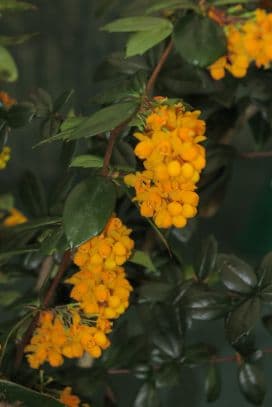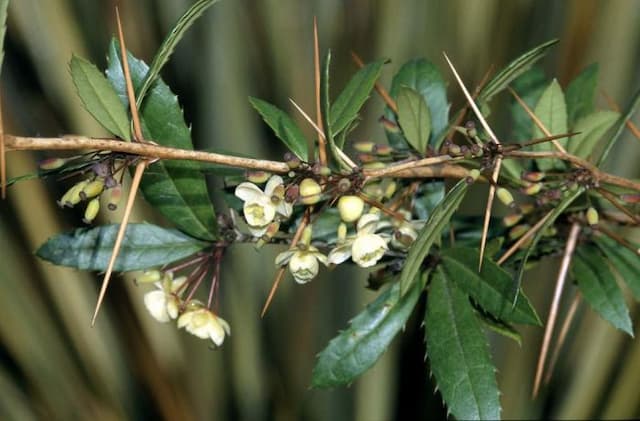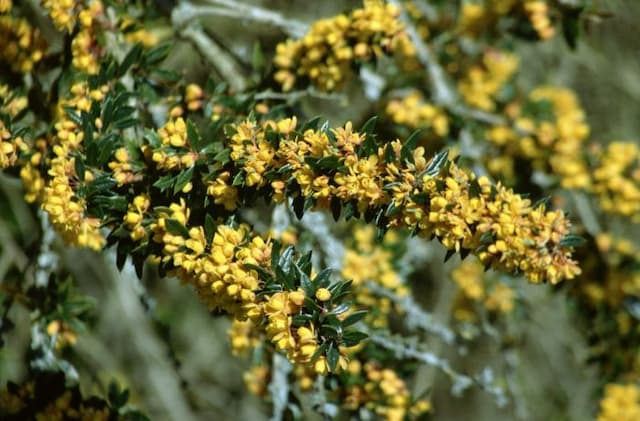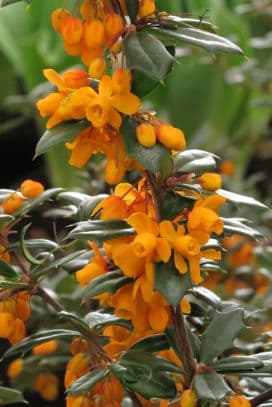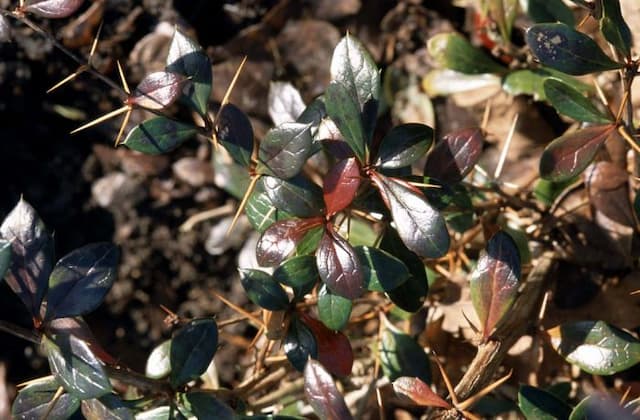David's epimedium Epimedium davidii

ABOUT
The plant commonly known as "Barrenwort" or "David's Epimedium" exhibits a graceful appearance with a dense clump of heart-shaped leaves, which display a variety of colors ranging from green to bronzy-red, especially when they first emerge and when the temperatures cool in the fall. The foliage is held on wiry stems that create a delicate visual texture. In the spring, the plant produces sprays of small, intricate flowers. Each bloom possesses an outer and inner set of petals; the outer petals are often sepals that are long and spurry, while the inner petals are smaller and can have a shape that gives them the common name of "bishop's hat." The flowers can be found in hues ranging from purple to pink to white, and they hover nicely above the foliage, creating the illusion of a cloud of tiny, colorful lanterns dancing in the breeze. As these flowers fade and the seasons change, the plant continues to maintain visual interest with its evergreen to semi-evergreen leaves, depending on the climate.
About this plant
 Names
NamesFamily
Berberidaceae
Synonyms
David's Fairy Wings, David's Epimedium
Common names
Epimedium davidii.
 Characteristics
CharacteristicsLife cycle
Perennials
Foliage type
Semi-deciduous
Color of leaves
Green
Flower color
Yellow
Height
1 feet 2 inches (35 cm)
Spread
1 feet 8 inches (50 cm)
Plant type
Herb
Hardiness zones
5
Native area
China
Benefits
 General Benefits
General Benefits- Enhances landscape aesthetics: Offers attractive foliage and dainty flowers, adding visual interest to gardens.
- Drought tolerance: Can survive with minimal water, making it suitable for xeriscaping and drought-prone regions.
- Shade tolerance: Grows well in partial to full shade, providing ground cover in less sunny spots.
- Deer resistance: Generally not preferred by deer, helping to prevent damage to the garden.
- Low maintenance: Requires little care once established, making it a convenient choice for busy gardeners.
- Seasonal interest: Produces flowers in spring, adding seasonal charm to garden landscapes.
- Ground cover: Spreads over time, filling in space and reducing weed growth.
 Medical Properties
Medical Properties- Libido enhancement: Epimedium species have been traditionally used in Chinese medicine to increase libido and improve sexual function.
- Osteoporosis treatment: Some studies suggest that icariin, a compound found in Epimedium, may help in the treatment of osteoporosis by promoting bone growth and density.
- Anti-inflammatory effects: Epimedium may contain flavonoids that possess anti-inflammatory properties, potentially beneficial in reducing inflammation.
- Neuroprotective properties: There are indications that Epimedium could have neuroprotective effects, possibly aiding in the protection against neurodegenerative diseases.
- Cardiovascular health: It is suggested that Epimedium might improve cardiovascular health by increasing blood flow and lowering blood pressure, although specific evidence for Epimedium davidii is limited.
 Air-purifying Qualities
Air-purifying QualitiesThis plant is not specifically known for air purifying qualities.
 Other Uses
Other Uses- As a groundcover in shady areas, Epimedium davidii, commonly known as David's epimedium, can thrive under trees where other plants may struggle to grow.
- In bonsai cultivation, some enthusiasts may use David's epimedium for its attractive leaves and potential for dwarfed growth in shallow pots.
- For wildlife gardens, the plant can provide an important early nectar source for bees and other pollinators.
- David's epimedium is sometimes utilized in landscape design for its textural contrast with other garden plants due to its heart-shaped leaves.
- In theme gardens, such as fairy or fantasy gardens, the delicate appearance of the plant adds an ethereal touch to the setting.
- Horticultural therapy uses David's epimedium for its low maintenance and resilient nature, making it suitable for therapy gardens where patients engage with plants.
- As a natural dye, the leaves can be used to create subtle green dyes for textiles or art projects, although this is not a common use.
- Gardeners may use dried epimedium leaves as a natural, decorative mulch in pots or garden beds to retain soil moisture and suppress weeds.
- The plant contributes to soil stabilization in sloped gardens because its roots can help to hold soil in place, reducing erosion.
- Dried stems and seed pods can be used for crafts or as part of naturalistic indoor floral arrangements during the fall and winter.
Interesting Facts
 Feng Shui
Feng ShuiThe plant Horny Goat Weed is not used in Feng Shui practice.
 Zodiac Sign Compitability
Zodiac Sign CompitabilityThe plant Horny Goat Weed is not used in astrology practice.
 Plant Symbolism
Plant Symbolism- Love and Attraction: Epimedium davidii, commonly known as Bishop's Hat, is often associated with love and attraction, possibly due to its aphrodisiac properties attributed to the plant in traditional medicine.
- Vitality and Fertility: The vitality of the plant's growth and its use in promoting fertility in traditional cultures lends it a symbolic meaning of vigor and procreation.
- Tolerance and Resilience: Bishop's Hat's ability to thrive in shady and challenging conditions symbolizes the qualities of endurance and adaptability.
 Water
WaterBishop's hat should be watered deeply once a week, providing about 1 gallon of water per plant, ensuring that the moisture penetrates the soil to reach the roots. During the growing season, especially in dry conditions, it may need twice weekly watering. Over winter, reduce watering but do not allow the soil to completely dry out. Always check the top inch of soil for dryness before watering and water less frequently when rain provides natural irrigation.
 Light
LightBishop's hat prefers partial to full shade, thriving best in dappled sunlight under the canopy of taller trees or shrubs. Avoid placing it in direct, harsh sunlight, as this can scorch the leaves and stress the plant.
 Temperature
TemperatureBishop's hat does well in a wide range of temperatures, surviving in zones 5 through 9, which can equate to winter lows down to -20 degrees Fahrenheit. The ideal growing temperature is between 50 and 70 degrees Fahrenheit during the day, avoiding extreme heat or cold.
 Pruning
PruningPrune Bishop's hat in late winter or early spring to remove dead and damaged leaves and promote fresh growth. Cut back foliage to ground level before new leaves emerge. It's typically sufficient to prune once per year during this time.
 Cleaning
CleaningAs needed
 Soil
SoilThe best soil mix for Epimedium davidii, commonly known as David's barrenwort, should be rich, well-drained, and humusy. A mixture of garden soil, peat moss or compost, and perlite or pumice works well to create an ideal environment. The soil pH for David's barrenwort should be slightly acidic to neutral, in the range of 5.5 to 7.0.
 Repotting
RepottingDavid's barrenwort should be repotted every two to three years to refresh the soil and give the roots space to grow. It is best to repot in early spring before new growth begins to ensure the plant settles well in its new container.
 Humidity & Misting
Humidity & MistingDavid's barrenwort thrives in average to high humidity levels, generally around 50% or higher. It prefers a moist environment consistent with its natural woodland habitat, but good air circulation is necessary to help prevent any fungal diseases.
 Suitable locations
Suitable locationsIndoor
Place David's barrenwort in a bright spot with indirect light and room humidity.
Outdoor
Plant David's barrenwort in dappled shade and shelter it from the hot sun.
Hardiness zone
5-9 USDA
 Life cycle
Life cycleEpimedium davidii, commonly known as Bishop's hat, begins its life cycle as a seed, which, when sown, germinates usually in the spring when soil temperatures rise. The seedlings develop into rosettes with heart-shaped leaves and in time, the plant establishes a rhizomatous root system, through which it can spread and become a ground cover. After a few years, the Bishop's hat reaches maturity and starts to produce its distinct flowers, typically in spring, that range in color from yellow to purple. The flowers are hermaphroditic containing both male (stamen) and female (ovary) structures, facilitating pollination by insects. Once pollination occurs, the flowers develop into seed pods that ripen and release seeds to complete the reproductive cycle. The plant is perennial and will go dormant in the winter, with foliage dying back, before regrowing the following spring from its rhizomes.
 Propogation
PropogationPropogation time
Spring to early summer
For Epimedium davidii, commonly known as David's barrenwort, the most popular method of propagation is by division. This is best done in the late summer to early fall, after flowering has ceased but while the plant still has time to establish roots before the winter cold sets in. To propagate by division, carefully dig up an established clump and gently separate it into smaller sections, making sure that each new section has a good amount of roots and a few shoots. These divisions can be immediately replanted in the garden at the same soil depth they were previously growing. The divisions should be watered thoroughly upon planting and kept moist until new growth indicates that the plant has begun to establish itself in its new location.

